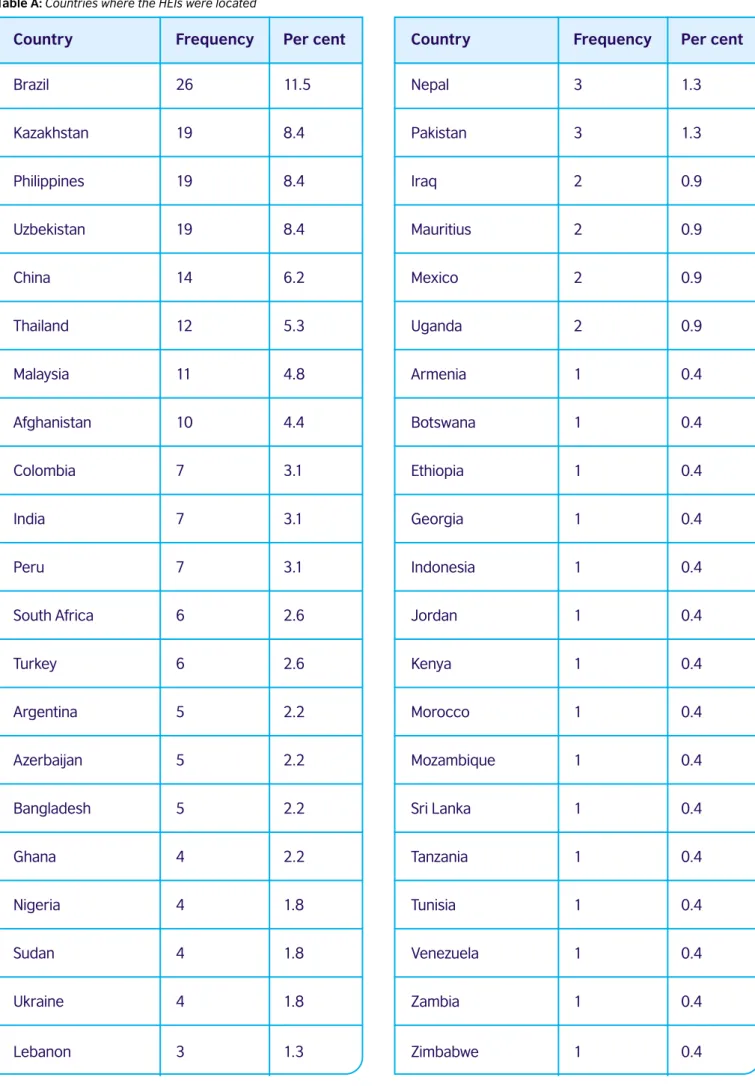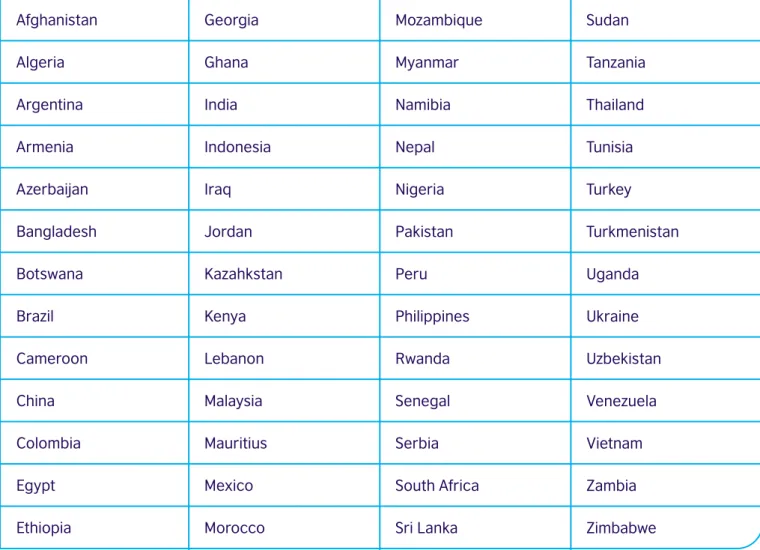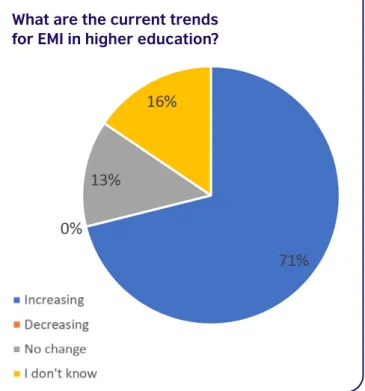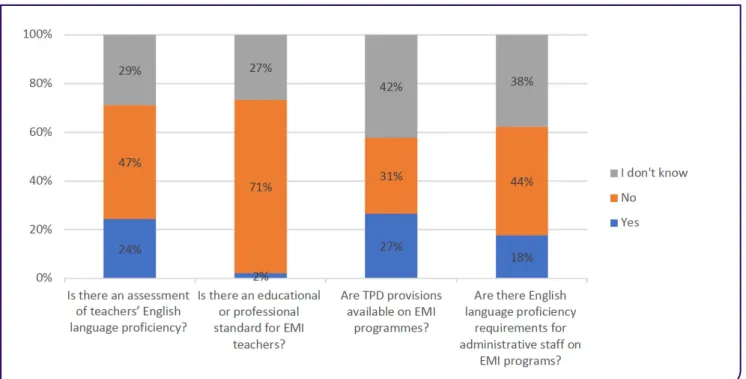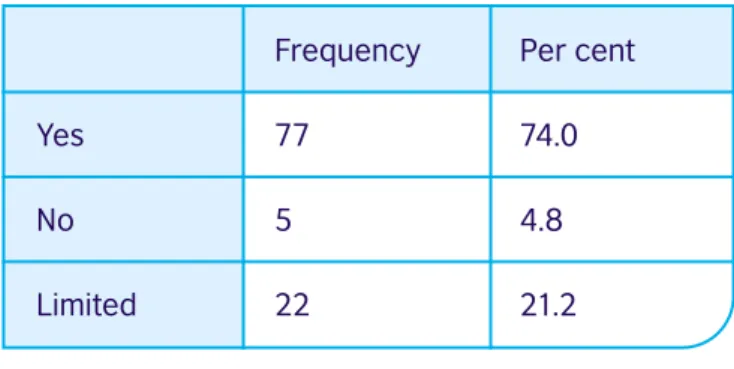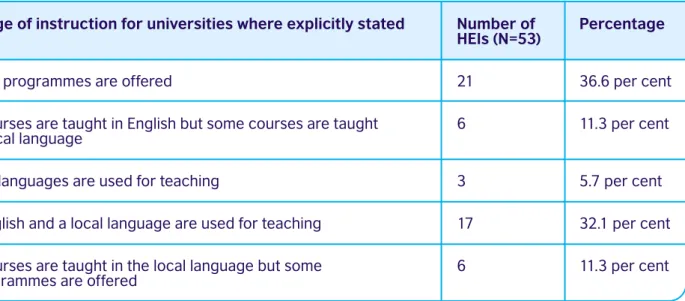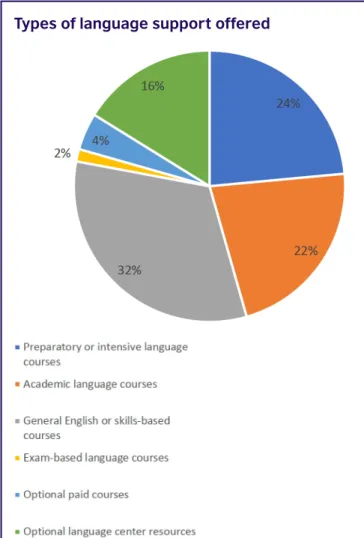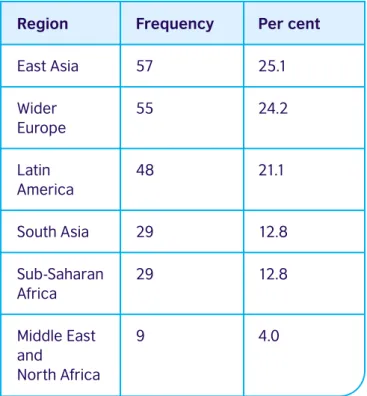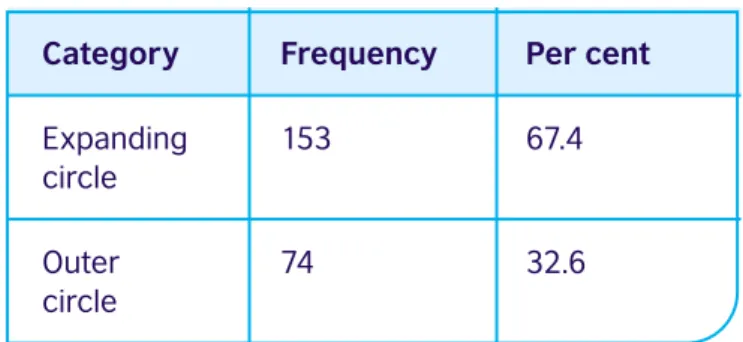Heath Rose (Principal Investigator) is Associate Professor of Applied Linguistics at the University of Oxford and Coordinator of the EMI Oxford Research Group. He is a lecturer in ELT at the University of Oxford and a fellow of EMI.
Previous research on EMI provision
The researchers found that the university students were likely to have fewer problems understanding the teacher than their high school peers (CLIL), possibly because the latter could self-select enrollment into a HE EMI program, while the former could not (CLIL in one program ). subject is compulsory in Italy). The data show that the L1 is widely used in both contexts, but especially in higher education institutions in China.
EMI in countries Officially Designated as receiving
Gender
- Survey of key players analysis
- Country responses
- Website analysis
- Survey of key institutional players
Following the Stage 1 country responses, we examined what information was available on university websites regarding EMI programs in each of the 52 countries. This decision was made to avoid leaving Latin America as a gap in our data for this phase of the study—the benefit of this region's inclusion was considered to outweigh the methodological issues associated with the adaptations to our data collection protocols.
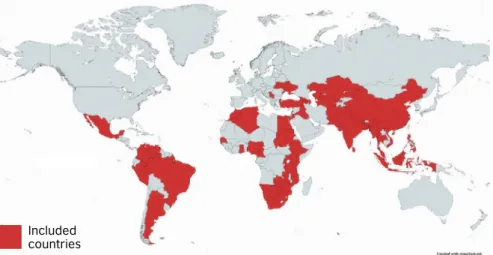
Ethical considerations
General EMI provision in higher education
Since 2002, the Language Policy for Higher Education in South Africa has promoted multilingualism in institutional policies and practices and has aimed to strengthen the role of African languages in higher education. The results from Phase 3 of our study suggest that English is a dominant language of instruction in South Africa.
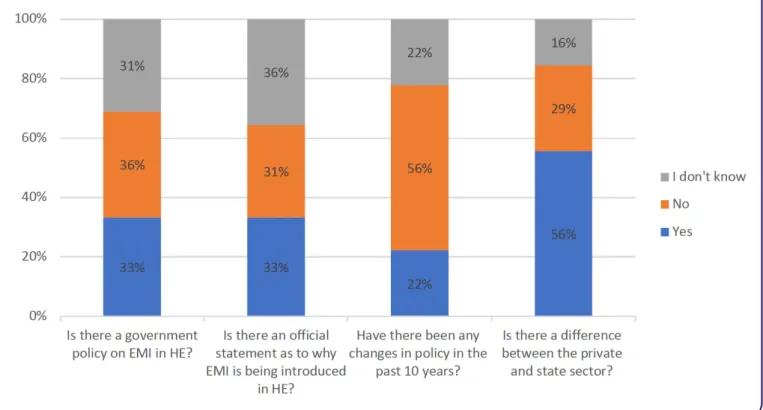
EMI provision by academic discipline
EMI university students
Among the 45 respondents, about half (n=19) stated that there are differences between the public and private sectors regarding the language requirements of students (Figure 5). In contrast, informants in China, Myanmar and Rwanda indicated that English language proficiency requirements at public higher education institutions tend to be higher. Regarding the recruitment of international students, only about half of the respondents (n=22) indicated that there are many students from abroad (Figure 5).
EMI university teachers and staff
Is EMI connected to the HEI’s internationalisation or strategic
When English was mentioned in connection with internationalisation, it was often to develop the language skills of students or staff or to increase the EMI offer. For example, the University of Yangon in Myanmar aims to improve its EMI programs and improve the English language skills of its academic staff to develop research and teaching. One aspect of the internationalization plan at the University of Novi Sad in Serbia is to offer more programs in foreign languages (our emphasis), although English is not specifically stated.
What is the language of instruction at the university?
In six higher education institutions, English was the main language of instruction, but some subjects (usually related to language, history or culture) were taught in the local language. On most websites of higher education institutions (n=88, 84.6 percent), we did not find the number of EMI/ programs. Thus, the transparency with which higher education institutions reported the number of EMI programs offered varied.
What are the admission criteria to EMI programmes?
Some higher education institutions offered more EMI programs at the postgraduate level, such as Chulalongkorn University in Thailand, which appeared to offer 17 undergraduate programs. Of the HEIs that listed proficiency exam results on their websites, requirements for postgraduate EMI programs generally exceeded requirements for undergraduate EMI programs (n=17). On the Stage 3 questionnaire, ten of the 12 respondents from Thailand indicated that there was an English proficiency requirement for undergraduate students to participate in EMI programs at their HEIs.
Does the university have a resource page on their website for international
What language support is provided for students?
At Al-Farabi National University of Kazakhstan in Kazakhstan, the language center's website indicated that it offered language support for English, Russian, and Kazakh. Instead of a language centre, some HEIs provided language support services through an academic resource centre, such as at NYU Shanghai in China and the University of Botswana in Botswana. Private HEIs were also more likely than public HEIs to describe language support for students on their websites.
What local language support is provided for international students?
What language requirements and support are there for teaching staff?
Information on English language support for teaching staff was found on only 16 HEI websites (15.4 per cent). The support was either focused on English language support courses - for example in Al Akhawayn University. Nazarbayev University in Kazakhstan; Ferhat Abbas Sétif University 1 in Algeria), or specific information regarding professional development was only available on internal websites accessible with institutional login (eg Ivane Javakhishvili Tbilisi State University in Georgia).
What are the language requirements for administrative staff working on
The majority of international students in EMI programs come only from regional or neighboring countries, and international students tend to make up only a small proportion of students enrolled in EMI programs. The English proficiency requirements for EMI's undergraduate programs tend to be at B1 or B2 level, while a B2. The main motivations for students to enroll in EMI programs were employment opportunities and study abroad opportunities.
Investigating the sample
Overview of English-medium instruction at respondent universities
Many of the HEIs (n=70) offered all university programs in EMI, while a similar number of HEIs (n=62) had less than 25 percent of their programs taught through English. The smallest number of HEIs (n=9) had about half of their bachelor's programs taught through the medium of English. In terms of differences by university type, private HEIs appeared to offer a higher proportion (at least 50 per cent) of postgraduate programs taught through English compared to state universities, although the same differences were not found in university level.
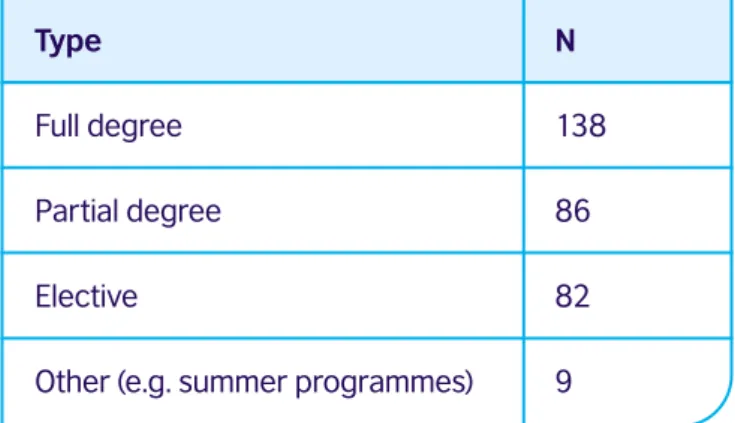
Student demographics
The proportion of female students enrolled in EMI programs was slightly smaller with an average of 48.4 per cent. The proportion of women enrolled in EMI programs also appeared to be lower in public HEIs compared to private HEIs. Respondents from private higher education institutions reported similar proportions of female enrollment overall (53.9 percent) and in EMI programs (52.0 percent).
English language requirements and support reported by universities
However, respondents at public institutions of higher education reported, on average, that 51.2 percent of the total student population was female, compared to 46.9 percent of women enrolled in EMI programs. The largest disparity in female enrollment was found in South Asia, where respondents reported that women make up 52.5 percent of the total student population, but that only 39.2 percent of students in EMI programs are female. In contrast, when higher education institutions where all programs were taught in English were included in the analysis, the proportion of women enrolled in EMI programs in South Asia increased and even exceeded the proportion of all women enrolled, with an average of 51.8 percent at EMI. programs compared to the overall 41.4% female enrollment in higher education institutions in South Asia (n=28).

Language support for students and staff
The results of the Level 3 questionnaire indicated that the most common forms of language support offered to students in higher education institutions in the Philippines were program-wide language classes (n=15) and independent study support (n=15). Other forms of support for EMI teachers include in-house training (n=3), online training materials (n=3) and mentoring opportunities (n=2). In addition, a 40-hour internal training course for EMI teachers was developed in 2019 at the Universidad del Pacifico.
EMI drivers and difficulties
Respondents from Latin America were also more likely than respondents from other regions to report intercultural improvement. Respondents from wider Europe were more likely to report that lack of international student enrollment was a challenge for EMI programs in their HEIs compared to respondents from other regions, while respondents from Latin America were more likely to report that the lack of enrollment of domestic students in EMI programs was. Respondents from Peru also reported that the most important objectives for their HEIs to offer EMI programs were preparing local students for the global labor market (M=3.86, SD=0.378), improving the intercultural competences of local students ( M=3.71, SD=0.488) and to build partnerships with universities abroad (M=3.57, SD=0.535).
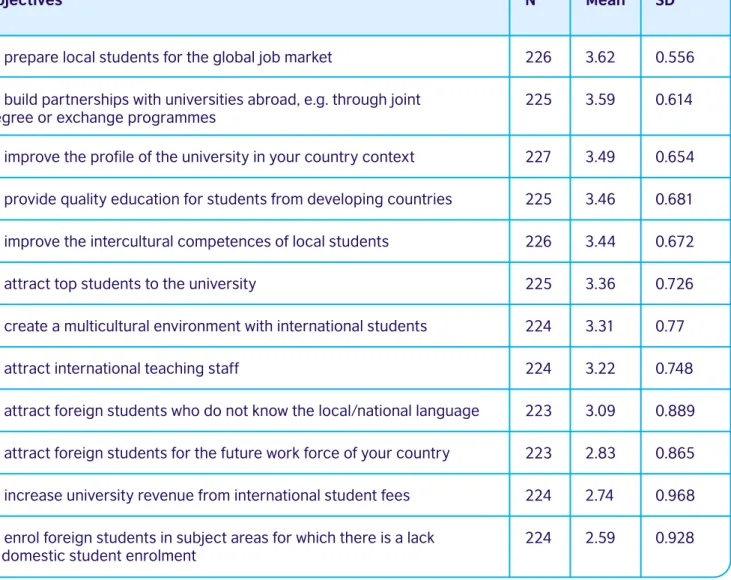
Case study 1: Ghana
To illustrate the themes of this report, we provide detailed case studies of EMI provision in three countries: Ghana, Brazil and Afghanistan. In contrast, Brazil is an Expanding Circle country with a relatively nascent history of EMI in its large HE sector. The diversity of EMI provision in these three countries illustrates the complexity and heterogeneity with which EMI is introduced, implemented and expanded across ODA recipient countries worldwide.
English language proficiency requirements
We have selected these three countries because they represent the diversity of historical and socio-cultural contexts, as well as the evolution of EMI provision, found in the sample of ODA recipient countries included in this report. An outer circle country where English is an official language, Ghana has a long history of EMI at all levels of education.
Language support for students
Respondents from Ghana reported in the Phase 3 questionnaire that female students accounted for an average of about 36.8 percent of students enrolled in their universities.
EMI teacher qualifications
Internationalisation
Case study 2: Brazil
Among the 19 respondents from Brazil who indicated that their higher education institutions offered EMI at the undergraduate level, 14 reported that there was no English proficiency requirement for entry. Respondents to the Stage 3 questionnaire from Brazil reported that 54.2 percent of students studying at their university were women. Six respondents reported that their HEI offered some form of EMI teacher training course for academic staff.
Case study 3: Afghanistan
According to the Phase 3 questionnaire, the main problem faced by HEIs on EMI programs is low English proficiency of teaching staff (M=2.45, SD=0.82). The findings of the Phase 3 questionnaire indicate that few international students are enrolled in EMI programs in Afghanistan. This seems to indicate that EMI programs in Afghanistan are not being established to attract international students.
Admission requirements to EMI programmes
The global labor market appears to be a driving factor behind this trend, as improving students' career prospects is a key motivation for both students enrolling in EMI programs and HEIs offering courses taught in English. However, in some countries (eg Brazil), elective courses offered in English are more common than full degree programs. Our analysis of HEI websites in Phase 2 suggests that some HEIs offer more EMI programs at undergraduate than postgraduate level, while other HEIs offer EMI programs mainly at postgraduate level.
Teacher professional development (TPD)
Internationalisation, higher education and the growing demand for English: an investigation of the English medium of instruction (EMI) movement in China and Japan. Macaro, E , Curle, S , Pun, J , An, J and Dearden, J (2018) A systematic review of English medium teaching in higher education. Rose, H , McKinley, J , Xu, X and Zhou, S (2020) Investigating policy and implementation of English medium education in higher education institutions in China.
